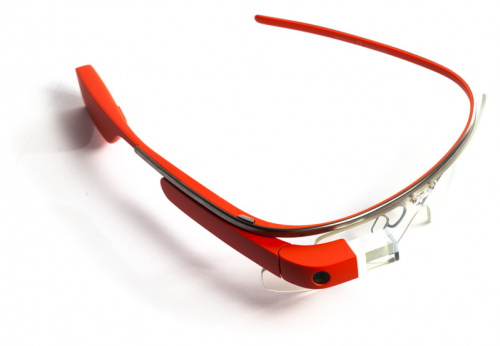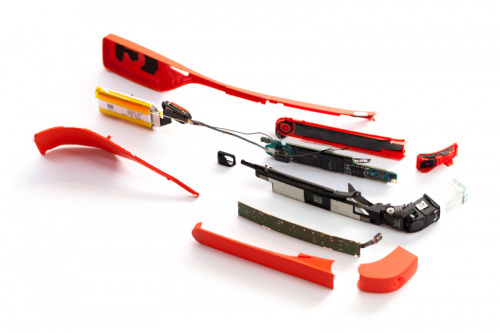If you're not familiar, the Google Glass is Google's amazing wearable computer/head-mounted display. Today, we are excited to offer the first-ever glimpse inside the Google Glass. But first, the backstory.
The exploded Google Glass in all its glory (Photos courtesy of Scott Torborg)
Our CEO, Nate Seidle, is friends with a woman by the name of Star Simpson. Star studied EE at MIT and co-founded Canidu, an outfit focused on tech education for kids. Along with longtime friend and fellow hacker collaborator Scott Torborg, she also co-founded the famous Tacocopter (tacos delivered via quadcopter - best idea ever).
Fast-forward to this past weekend, when Star headed out to the SparkFun Autonomous Vehicle Competition to check out some of the robotics action. Nate ran into her and found out that she and Scott were picking up a Google Glass on Sunday. Not only were they getting their hands on this highly-coveted device, but like good hackers, when they get their hands on an expensive piece of hardware, they tear it apart and see what makes it tick. While a "sorta teardown" of the Glass has been done, no one has yet to take it down to circuit boards and chips. This was something SparkFun has wanted to do for quite a while, but getting your hands on a Google Glass is not exactly easy.
Pre-surgery
So Nate made a proposition - SparkFun would "sponsor" the teardown (pay for the hardware) if we could be the first to feature it. And much to our excitement, they agreed!
So Star and Scott picked up the Glass on Sunday afternoon and quickly got to tearing it down.
Removing the main board
"It's surprisingly simple."
We believe it's only fair that they get the glory for this - afterall they're the ones who got the Glass and did the teardown. So check out this website for the full teardown of the Google Glass. It's absolutely amazing!
Thank you, Star and Scott, for letting SparkFun be a part of this awesome adventure!










Thank you Star and Scott for tearing apart something so coveted! Tear downs like this help feed our constant curiosity of how things work.
Well done, Star and Scott - this is awesome. Also, thank you for sponsoring this, Nate!
Awesome teardown. I wanted to see what else was on the website, so I modified the url to point to http://www.catwig.com/. Was not disappointed.
Does what it says on the tin.
640x360 ?? Holy cow, my (very) pre-Glass wearable hack has better resolution. I'm suddenly tempted to rejuvenate that project, lol.
EDIT: Don't get me wrong, that's still pretty great considering their display is slightly less obstructive. The interface seems really nice as well. I'm psyched about what Google is doing to bring wearable and ubiquitous computing to fruition. It's just encouraging to see that they weren't able to totally spank my long labor of love in screen resolution. I wonder if it's a Kopin display or if it's custom by someone else?
If SF sold a microdisplay like this, I would wreck my monitor trying to pay you.
We never could because every time a shipment came in I'd order them all.
I've literally been lobbying for micro-displays since my job application. I think the margin will either be really thin or it will be a really expensive part. I will admit, though, my experience in tearing down cheapo "myvu" sets for displays has me thinking someone in China must have a connection.
I'll reopen this discussion with the engineers. Maybe we can get a monocular display with modest resolution, some optics and an HDMI driver from the people who make ebay iPod video glasses.
I had researched on this several years ago. Back then, IIRC, Kopin sold their QVGA binocular microdisplay module in single quantities of $230 (it used to be on their website actually). Also remember, that Wowee had in their $100 RC camera car (I have one of the original ones on clearance for $40 years ago) a cheap RC car, IR sensitive camera, and analog video transmitter, going to a black and white QVGA monocle headband with a 1/8" plug providing power and standard composite video feed to the screen. Bulky, but the optics tend to cost as much as the display, if not more, at smaller sizes.
In fact, the Wayback machine resurrects their posted 2009 prices for their electronic viewfinders.
CyberEVF 230K $125 (QVGA monocle) BDM-230K $200 (QVGA dual display) BDM-922K $400 (VGA dual display)
Not quite the same thing, but we're looking into sugar-cube-sized picoprojectors. The long eye relief optics in Glass are a big part of the magic as well. Valid leads for affordable tech are always appreciated.
Thanks Nate for sponsoring this tear down. It was interesting to see what goes into a cutting edge product developed by one of the most tech capable companies around. Apparently this is what near infinite financial, intellectual, and technical resources will get you. I haven't been following google glass so I was kinda surprised to hear this was the first in depth-'ish tear down. I assume google is smart enough to know that sooner or later someone would do a detailed tear down. I wonder why google didn't just publish their own detailed tear down. Maybe they were concerned about their privacy.
Super awesome work guys. Stoked that you guys sponsored this teardown.
I'm looking to build a project with a bone conduction speaker. Any chance you can let me know what was used in Google Glass? Seems like a good small unit to start with. I cannot see enough details in the photos to figure out the source of that unit.
I love how there is ">9K" printed on the PCB. If I am ever able to write apps for Glass I'll write one that scans bar codes and assigns power levels depending on their product rating.
How about getting the MPU-9150 (PDF)? Seems like the logical progression from the MPU-6000. With external pressure sensor support and a GPS, you have a complete autopilot solution!
Um, there's this... https://www.sparkfun.com/products/11486
With all the money I spend through you guys, I paid for this by myself.
But seriously, thanks for sponsoring this teardown. It's stuff like this that keeps me coming back and supporting Sparkfun. You guys are awesome!
Hmm, now someone will have to teardown the Xbox One and PS4 when they come out!
I'm not trying to go to jail.
It definitely puts the crowdfunding maker movement in perspective when you read about what MIT graduates, going through the traditional Ive League venture capital process, are doing.
Don't confuse capability with means.
In Glass, everything short of the PCB, plastics, and metal band are off the shelf, so I'd say it's more a matter of a large team of talented engineers with a significant budget. CastAR and Oculus Rift were prototyped on shoestring budgets, with hot glue and duct tape, and the initial development teams for both combined would fit in a minivan.
Huzzah for teardowns!